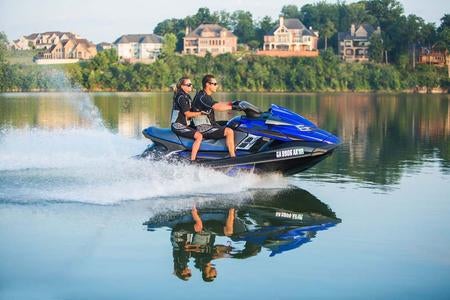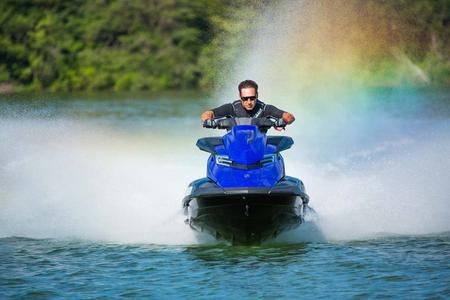2014 Yamaha FX SVHO Review
The fastest - and arguably best - WaveRunner yet.
Talking to U.S.-based Yamaha reps, you get the feeling they’ve been begging Japan for more power for quite some time. For 2014, they – and likely many consumers – get their wish in the form of the FX SVHO, a model that I recently piloted to a top speed of 71.5 mph on near perfect conditions outside Atlanta.
Yes, this craft was an early release, and full-scale production always seems to result in ever-so-slightly tamer craft. The SVHO also certainly benefitted from my light weight, light fuel load, and my experienced hand when it comes to radar testing. But outside factors aside, the brand’s intention seems crystal clear.
Read our about the 2014 Yamaha Lineup
Yamaha no longer plans to come in a distant second in the speed department.
Power … With A Capital P
The source of all that power is Yamaha’s new-for-’14 Super Vortex High Output (SVHO) engine. While it’s based on the existing 1.8-liter, the SVHO engine has a decidedly “aftermarket” feel about it. Its key component is an all-new supercharger and larger intercooler, the latter of which Yamaha claims to be 25% more efficient than the previous design. The engine also features a larger, 110% more-efficient oil cooler to help dissipate heat, larger fuel injectors to flow more fuel when needed, and far stronger forged-steel pistons. Add in additional tweaks and the SVHO is said to deliver 20% more power than the next-in-line SHO engine, and a dramatic 60% greater boost.
COMPARE: Read our review of the 2013 Yamaha FX SHO
Horsepower? None of the manufacturers are into claiming that any more, but Yamaha reps couldn’t resist pointing out the engine surpasses the horsepower of Sea-Doo’s RXP-X 260 by five percent. Considering the actual horsepower of that engine is about 239.9, it’s a good guess the SVHO pumps out somewhere in the neighborhood of 252 horses. Taking into account its lighter weight NanoXcell hull material, that’s apparently just the number needed to run neck-in-neck with the competition.
Obviously, the existing pump design required some modifications to keep up. To handle the additional power on tap, pump diameter has been increased from 155 to 160mm, and the internals now reflect a “race-inspired” eight-vane design. Perhaps more striking, the job of loading that pump now falls to a new top-loader scoop grate, a style Yamaha has never before offered. (Why? Yamaha is notoriously conservative when it comes to areas of liability. A standard grate offers one additional bar, making it harder for anything to get sucked into the pump. A scoop grate is also subjected to greater force, hence an additional set of bolts to make sure it stays firmly in place.) The FX SVHO rideplate has also been extended.
Confident Ride
What’s so astonishing about going 71.5 mph on an FX model is how utterly comfortable I felt at that speed. Halfway through one run I encountered an unexpected set of wakes that would typically produce a few anxious moments. Instead, the FX hull charged over them with ease. With the right body positioning and anticipation, I was also able to rail the boat into corners at near full throttle and not get launched, and punch it out of the hole and hit the 30 mph benchmark well under two seconds. While a stopwatch and GPS pale in comparison to a legitimate radar gun and acceleration-testing software, I’m calling the ballpark figure as quick as 1.5 seconds.
Make no mistake, that’s scary speed in the hands of a novice rider, and I would strongly urge the boat stay in the hands of experienced pilots no matter how well the hull handles it. But in the hands of an experienced watercraft enthusiast, the FX SVHO is arguably downright thrilling. It’s instantly on par with the Kawasaki Ultra or Sea-Doo GTX/RXT models.
Part of the reason for the confident handling is the longer hull and redesigned sponsons that debuted in 2012. Previously, the FX could display a jerky characteristic as it rolled between the running pad and chines as it carved through a turn. The ’12 change, however, resulted in a craft that smoothly and predictably rolled into a corner. The more powerful midrange acceleration now just seems to enhance that personality, especially if coupled with judicious use of the manual trim to drop the bow in the corners and raise it on the straightaways.
The lone negative I’ll still note is the manual side of that trim. At speed, a tremendous amount of thrust is exiting the nozzle. Sometimes the force of all that water makes it harder to pivot the nozzle. Overall, however, this is a boat that works almost just the way you want it to … and then some.
Beyond Performance
It’s easy to get caught up in the performance aspect of the FX SVHO, but take a step back and you’ll realize this remains a pretty civilized watercraft. Its broad array of features include a mechanical neutral, activated by pulling the reverse lever until it snaps into a middle position that results in no real forward or backward movement; the Command Link control center, which relocates the display’s mode buttons to the space between the handlebars and saddle, making operation far easier; a remote transmitter that can be used to lock the ignition out to prevent unauthorized use, or to activate a low RPM mode to limit speeds; and electronic throttle, which makes possible both cruise control (great on long rides or when towing skiers and wakeboarders) and a no-wake mode.
Other features of note include tilt steering, a multiple-position boarding system that uses both a spring-loaded, flattened step and multiple handholds, grooved, two-tone HydroTurf traction mats, and a handy aft stowage compartment that’s great for wet gear and even includes a notch for an attached watersports towrope. The saddle, and overall rider ergonomics, are also quite comfortable.
RESEARCH: All of our Yamaha WaveRunner reviews
Still, my final thoughts can’t help but return to its power. The FX SHO was, and still is, a formidable machine. The competition, however, held a definite edge in horsepower. Now, with the FX SVHO, that gap has been effectively erased.
And now, the race is on.
| 2014 Yamaha FX SHVO Specs | |
| Length | 140.2 inches |
| Beam | 48.4 inches |
| Dry Weight | 873 lbs |
| Engine | Supercharged w/intercooler 4-cylinder EFI |
| Displacement | 1812 cc |
| Bore and Stroke | 86mm x 78mm |
| Compression Ratio | 8.6:1 |
| Rated Horsepower | N/A |
| Fuel Capacity | 18.5 gal. |
| Combined Stowage Capacity | 33.2 gal. |
| Colors | Deep Blue Metallic or Black Metallic |
| Price | $14,799 |
Get PersonalWatercraft.com in your Inbox!
Like PersonalWatercraft.com on Facebook
Comments
Most Popular

Remembering the Sea-Doo XP

2025 Yamaha JetBlaster PRO 2-Up Review

2024 Yamaha GP HO Review

2024 Kawasaki Jet Ski STX 160X Review

2017 Kawasaki Jet Ski Ultra 310LX Review
















 Your Privacy Choices
Your Privacy Choices